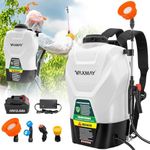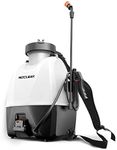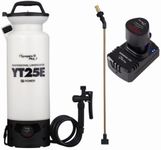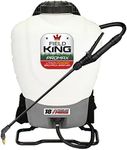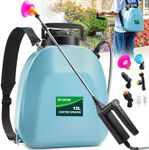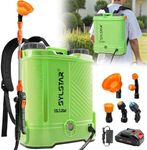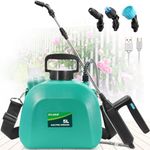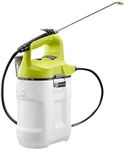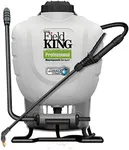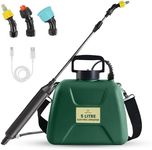Buying Guide for the Best Battery Garden Sprayers
When choosing a battery garden sprayer, it's important to consider the specific needs of your garden and the tasks you plan to perform. Battery garden sprayers are convenient for applying fertilizers, pesticides, and herbicides efficiently and evenly. They eliminate the need for manual pumping, making them easier to use over large areas. To find the best fit for your needs, consider the following key specifications and how they align with your gardening tasks.Battery CapacityBattery capacity, measured in ampere-hours (Ah), determines how long the sprayer can operate on a single charge. A higher capacity means longer usage time, which is crucial for larger gardens or extensive spraying tasks. Battery capacities can range from around 2Ah to 8Ah or more. If you have a small garden or only need to spray occasionally, a lower capacity may suffice. For larger areas or frequent use, opt for a higher capacity to avoid frequent recharging.
Tank CapacityTank capacity indicates how much liquid the sprayer can hold, usually measured in liters or gallons. This is important because it affects how often you need to refill the tank during use. Smaller tanks, around 1 to 2 gallons, are suitable for small gardens or spot treatments. Larger tanks, 3 to 5 gallons or more, are better for extensive areas or when you want to minimize refilling. Choose a tank size that matches the scale of your gardening tasks.
Spray PressureSpray pressure, measured in pounds per square inch (PSI), affects the reach and coverage of the spray. Higher pressure allows for a finer mist and better coverage, which is useful for reaching tall plants or dense foliage. Typical pressures range from 40 to 70 PSI. For general garden use, a moderate pressure is usually sufficient. If you need to cover large areas or have specific plants that require precise application, consider a sprayer with adjustable pressure settings.
Nozzle TypesNozzle types determine the spray pattern and droplet size, which can affect the efficiency and effectiveness of the application. Common types include fan, cone, and adjustable nozzles. Fan nozzles are good for even coverage over flat surfaces, cone nozzles are ideal for targeted applications, and adjustable nozzles offer versatility for different tasks. Consider the types of plants and areas you will be spraying to choose the appropriate nozzle type.
WeightThe weight of the sprayer, especially when filled, affects how easy it is to handle and maneuver. Lighter sprayers are easier to carry and use for extended periods, which is important if you have a large area to cover or if you have physical limitations. Weights can vary significantly, so consider your own strength and endurance when choosing a sprayer. If possible, test the weight of the sprayer when filled to ensure it is manageable for you.
Battery Charging TimeBattery charging time is the duration it takes to fully recharge the battery. This is important if you need to use the sprayer frequently or for long periods. Charging times can range from a couple of hours to overnight. If you plan to use the sprayer often, look for models with shorter charging times or consider purchasing an additional battery to swap out when needed. This ensures you can continue working without long interruptions.

